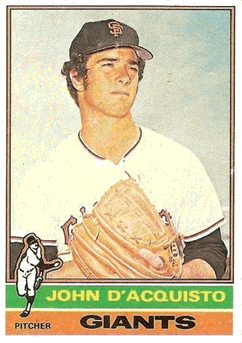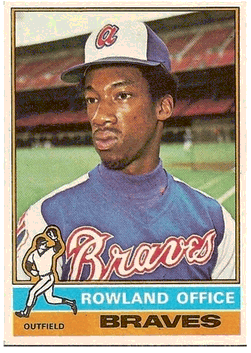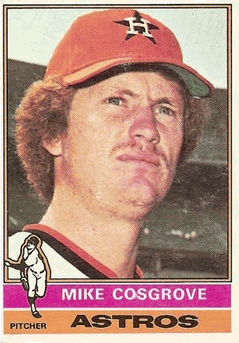Cardboard Gods (6 page)
Authors: Josh Wilker

Topps 1976 #628: John D'Acquisto





I started having nightmares, except they weren't nightmares, but we didn't know what else to call them. Years later, still trying to understand this inexplicable part of my childhood, I discovered that the accepted term for these episodes was “night terrors.” I recognized the physiological and observable elements related to the term: jackhammer heartbeat, shortness of breath, the young subject running and thrashing and screaming as if unable to escape a vision of bottomless horror. But the book that described the phenomenon claimed that children who experience night terrors are not even aware of them as they happen; they are in a kind of sleepwalking trance and don't remember them the next day. Neither claim was true.
I woke in the dark, the whole house quiet, and things looked wrong, out of proportion, or as if there were no such thing as proportion, a baseball and a wall and a shoe all simultaneously gigantic and microscopically small. I got out of bed and it got worse. Jackhammer heartbeat, shortness of breath. Floor, door, staircase, stairsâeverything seemed to have shed its name.
And I remembered all this the next day, my throat still hoarse from screaming. I remembered how everything had looked wrong and how this fed into a spiraling fear that there was no way back to the normal world, that the terror would be endless. I remembered the expressionâfright, worry, exhaustion, helplessnessâon Mom's face and Tom's face and Ian's face, no one able to stop what was happening. And beyond merely remembering, I felt it all flickering at the edges of the daylight world, the name of every object a thin, slipping rag above a kind of awful infinity.
On days like that, I went to my cards with more need than usual. I held them and read them aloud, the numbers, the names. Everything seemed a little foggy on those days, one name bleeding over its borders into the next. This was especially true if I happened to venture, as if drawn to an implacable feeling of melancholic absence and aftermath, into my dreary collection of San Francisco Giants.
I had never seen the San Francisco Giants on television. They never surfaced in
Sports Illustrated
or anywhere near the top of the most distant of all divisions, the National League West. In the All-Star Game their yearly lone representative was no more noticeable than the half-second blip in the corner of the screen made by a white-shirted extra fleeing ruin in a disaster film. They seemed to me in those years, which were just after their iconic superstar Willie Mays had departed, to be not so much a team as a state of being, or somehow a lack of a state of being. A mystery. A mist.
Sports Illustrated
or anywhere near the top of the most distant of all divisions, the National League West. In the All-Star Game their yearly lone representative was no more noticeable than the half-second blip in the corner of the screen made by a white-shirted extra fleeing ruin in a disaster film. They seemed to me in those years, which were just after their iconic superstar Willie Mays had departed, to be not so much a team as a state of being, or somehow a lack of a state of being. A mystery. A mist.
Gary Lucas was Gary Lavelle. Garry Maddox was Gary Matthews. When Garry Maddox was traded to the Phillies, leaving the blurring haze of San Francisco to become a distinct personality (the Minister of Defense), Gary Thomasson and Gary Alexander drifted into the ever-expanding Gary-laced void.
But it wasn't just the Gar(r)ys. I confused Ray Sadecki with Mike Sadek, Mike Ivie with Mike Lum, Jim Barr with Steve Barr and Doug Bair (and, later, Steve Farr), and for reasons that I can't explain I thought of Von Joshua as the fourth Alou. The fog of the mid- to late-'70s San Francisco Giants would also come to encompass blur-rings of identities across the years, Bob Knepper merging into Bob Kipper, Tim Foli merging into Tom Foley, Ed Halicki merging into Mike Bielecki who merged into Bob Milacki.
At the center of the fog was John D'Acquisto, who in my earliest years among night terrors and gods was one and the same with John Montefusco. As I got older I slowly came to understand the difference between John D'Acquisto and John Montefusco, but I was only able to absorb this information (which allowed me to identify several colorful individual facets of the latter figure, such as that he had won a Rookie of the Year award, had pitched a no-hitter, and was known far and wide as the Count of Montefusco) after John D'Acquisto was removed from the Giants in a trade to the Cardinals for, among others, Dave Rader, whom I then began to confuse with Doug Rader.
Trying to grab at the diaphanous handholds of names could only take me so far. When the day after a nightmare came to an end I went to bed tired and frightened, wondering if I'd make it through the night without waking up and seeing once again that everything was actually something else. It was dark and I didn't want to go to sleep. I wanted to keep saying names.
“Hey,” I said. “Hey, Ian.”
Topps 1976 #256: Rowland Office
In Randolph Center, any additions to my baseball card collection had been discussed, or at least had the potential to be discussed, in a small but palpable community of Randolph Center baseball card collectors that included me, my brother, Buster, Buster's good-natured friend George (who didn't allow his good nature to keep him from swindling me, a mere toddler, practically, out of my 1974 Hank Aaron “Home Run Champion” card), and sometimes even some other kids from the town. In East Randolph, collecting baseball cards became something far more solitary, but even when I was looking at my cards by myself, I was on some level imagining that at some point I would share my thoughts and discoveries with my brother.
And though my brother would increasingly recoil from the idea that we comprised a two-boy community unto ourselvesâan idea I was more than willing to embraceâin those early years in East Randolph he was often as interested in playing with me and sharing with me as I was with him. Mom and Tom worked very hard to make the bedroom my brother and I shared livable by tearing out the BB-RIDDLED walls and putting up new ones, but my brother and I claimed the room as our own by laughing our asses off at baseball cards.
The 1976 Rowland Office card that came into our lives in our first spring in the house, after a long, cold winter, did as much as any card to achieve this goal. Something about it caused both of us to erupt, sprawling on the floor, cards scattered all around us, loose and in rubber-banded stacks. And this didn't just happen the first time we saw the card. We'd be sorting new cards into our teams, and
one of us would hold up our version of this Rowland Office card for the other to see. The holder of the card would have his lips clamped shut, trying not to laugh until the other looked up to see.
one of us would hold up our version of this Rowland Office card for the other to see. The holder of the card would have his lips clamped shut, trying not to laugh until the other looked up to see.
Looking at the card now, I honestly don't know what caused us to roll around on our bedroom floor laughing until we cried. The name is cartoonish, the face unusually long and thin, the lips pursed as if a sour remark is about to be uttered about the stench of a teammate's flatulence. I mean, I guess he's kind of funny looking. But now, weighed down by all my years, I also see a young guy, much younger than I am now, trying to stick in the majors, trying to hold on to what is probably the only thing he knows how to do really well. I find myself focusing on his eyes, which seem alert and unsure, like those of a deer ready to bolt at any sign of trouble. I see a human where once I only saw a ridiculous god, a god who had and still has few peers in my imagined personal pantheon. He was the god of laughing fits, returning year after year to sacrifice himself in our brotherly rituals.
Topps 1977 #5: 1976 Victory Leaders
On July 28, 1976, Randy Jones went 10 innings in a 2-1 victory to push his dazzling record to 18 wins and 4 losses. After a rocky start to his career that included an 8-22 season, Jones had broken through in 1975 with 20 wins, and in 1976 he looked to be heading to superstardom.
Sports Illustrated
even featured him on their cover, wondering if he could become the first National Leaguer since Dizzy Dean to win 30 games.
Sports Illustrated
even featured him on their cover, wondering if he could become the first National Leaguer since Dizzy Dean to win 30 games.
By then I had finished my first year in a new class invented by the hippie parents scattered through the area. There were no grades, in both senses of the word: Kids of all ages were together in one room, and hierarchical assessment of academic achievement had been abolished. The idea was that we were free to learn what we wanted to learn, however we wanted to learn it, that every little boy and girl would find a way to burst into bloom. I learned about Indian tribes and feelings and how to say words in Russian and I wrote stories and plays and even an imitation of a television show using a cardboard box with an opening in the front that displayed a paper scroll filled with my tale in bright crayon about a bionic flea. Sometimes as I was walking to school I broke into a run.
Â
There was a brief moment in time when it seemed the answer to everything was Yes. Anyone could burst into bloom. You didn't have
to be among the few and chosen. Randy Jonesâjunk-ball-tossing Randy Jones, pale-skinned bozo-haired Randy Jones, thin-lipped dough-faced Randy Jones, Randy Jones in his Padres fast-food uniform, surrounded by feckless Padres teammates and empty seats and the blissfully indifferent blue of a Padres skyâwas every bit as good as Jim Palmer.
to be among the few and chosen. Randy Jonesâjunk-ball-tossing Randy Jones, pale-skinned bozo-haired Randy Jones, thin-lipped dough-faced Randy Jones, Randy Jones in his Padres fast-food uniform, surrounded by feckless Padres teammates and empty seats and the blissfully indifferent blue of a Padres skyâwas every bit as good as Jim Palmer.
Â
Our classroom was located in the East Randolph elementary school, and kids from the regular classes made fun of us. The general gist of the taunting was that we were retarded. One day as I was leaving the general store with a pack of cards a couple kids my age from a regular class fell in behind me. One of them, Muskrat, started making marching sounds in time to my steps.
“Hu-
lef
, hu-
lef
, hu-
lef
rah lef.”
lef
, hu-
lef
, hu-
lef
rah lef.”
“Hey, doofus,” the second one, Denny, said. “How many hours in a day?”
“Hey, yeah,” Muskrat said. “How many days in a week?”
“He doesn't know. They don't know shit.”
“Hey, how do you spell
dog
? How do you spell
cat
?”
dog
? How do you spell
cat
?”
“Why is your hair so curly and long?” Denny said. “You must be a woman.”
“Why are you a woman?” Muskrat said.
Â
Sometimes a pack of cards couldn't do much for you. Sometimes it was full of nothing but guys you already had and checklists and highlights and league leaders. Sometimes when you got home and opened it you wished that you had picked a different pack from the box in the store. But what else was there to do? Dump the doubles onto the doubles pile, glare at the checklists, and try to learn somethingâyou were always free to learn somethingâfrom the drab highlights and leaders.
Â
Later in 1976, the magic dissipated for Randy Jones. He didn't get close to 30 wins and never finished another season with more wins than losses. Meanwhile, Jim Palmer, shown in the 1976 Victory Leaders card without headgear for no apparent reason other than to display that his flowing blow-dried hair is spectacularly superior to Jones's cap-crushed rusted Brillo, continued tanly vying for Cy Young awards, breezing into the playoffs, and posing for lucrative
underwear ads. To this day, I find myself wishing what Randy Jones seems to be wishingâthat he could somehow cross over from his photo to the golden realm of the AL Victory Leader and kick Jim Palmer in his Jockey-shorted nuts.
Topps 1976 #122 Mike Cosgroveunderwear ads. To this day, I find myself wishing what Randy Jones seems to be wishingâthat he could somehow cross over from his photo to the golden realm of the AL Victory Leader and kick Jim Palmer in his Jockey-shorted nuts.

Other books
The Drowner by John D. MacDonald
The Maggot People by Henning Koch
Horde of the Demon Priest (Demona Book 3) by Megan A. Hepler
A Highlander's Heart: A Sexy Regency Romance (Highland Knights Book 1) by Jennifer Haymore
Wolf's-own: Koan by Carole Cummings
Red Ochre Falls by Kristen Gibson
Of Irish Blood by Mary Pat Kelly
Alone In The Trenches by Vince Cross
Spicy by Lexi Buchanan